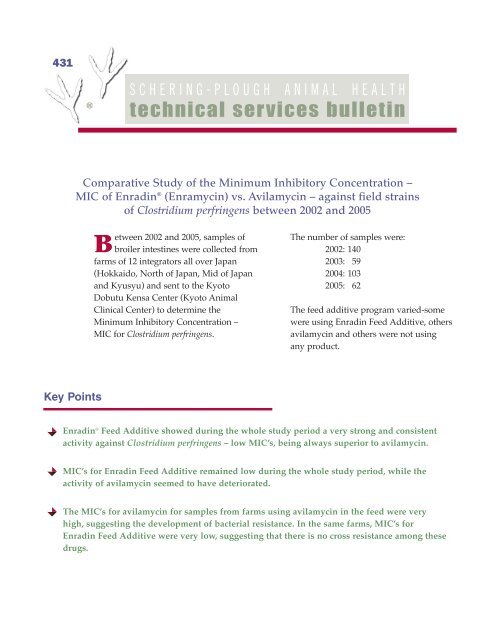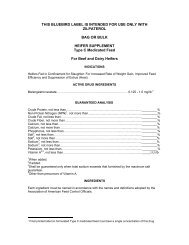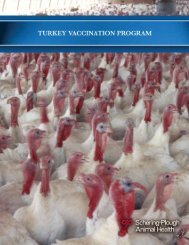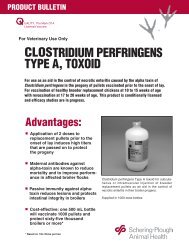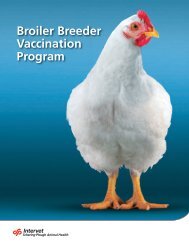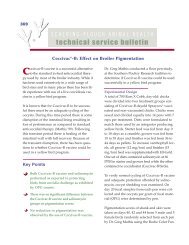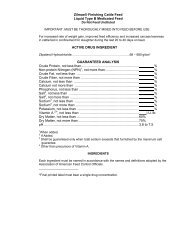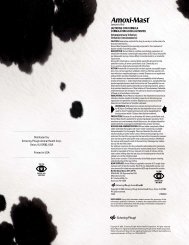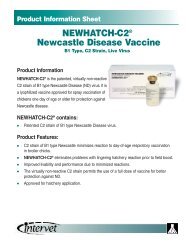Comparative MIC Enradin vs Avilamycin 2002 - 2005 - Merck Animal ...
Comparative MIC Enradin vs Avilamycin 2002 - 2005 - Merck Animal ...
Comparative MIC Enradin vs Avilamycin 2002 - 2005 - Merck Animal ...
- No tags were found...
Create successful ePaper yourself
Turn your PDF publications into a flip-book with our unique Google optimized e-Paper software.
431SCHERING-PLOUGH ANIMAL HEALTHtechnical services bulletin<strong>Comparative</strong> Study of the Minimum Inhibitory Concentration –<strong>MIC</strong> of <strong>Enradin</strong> ® (Enramycin) <strong>vs</strong>. <strong>Avilamycin</strong> – against field strainsof Clostridium perfringens between <strong>2002</strong> and <strong>2005</strong>Between <strong>2002</strong> and <strong>2005</strong>, samples ofbroiler intestines were collected fromfarms of 12 integrators all over Japan(Hokkaido, North of Japan, Mid of Japanand Kyusyu) and sent to the KyotoDobutu Kensa Center (Kyoto <strong>Animal</strong>Clinical Center) to determine theMinimum Inhibitory Concentration –<strong>MIC</strong> for Clostridium perfringens.The number of samples were:<strong>2002</strong>: 1402003: 592004: 103<strong>2005</strong>: 62The feed additive program varied-somewere using <strong>Enradin</strong> Feed Additive, othersavilamycin and others were not usingany product.Key Points<strong>Enradin</strong> ® Feed Additive showed during the whole study period a very strong and consistentactivity against Clostridium perfringens – low <strong>MIC</strong>’s, being always superior to avilamycin.<strong>MIC</strong>’s for <strong>Enradin</strong> Feed Additive remained low during the whole study period, while theactivity of avilamycin seemed to have deteriorated.The <strong>MIC</strong>’s for avilamycin for samples from farms using avilamycin in the feed were veryhigh, suggesting the development of bacterial resistance. In the same farms, <strong>MIC</strong>’s for<strong>Enradin</strong> Feed Additive were very low, suggesting that there is no cross resistance among thesedrugs.
Figure 3. <strong>Enradin</strong> from <strong>2002</strong> to <strong>2005</strong>Number of Strains<strong>MIC</strong> (mcg/mL)Figure 4. <strong>Avilamycin</strong> from <strong>2002</strong> to <strong>2005</strong>Number of Strains<strong>MIC</strong> (mcg/mL)
Figure 5. <strong>MIC</strong> comparison of Clostridium perfringens between Enramycin and <strong>Avilamycin</strong>in samples collected from farms using <strong>Avilamycin</strong>.Number of Strains<strong>MIC</strong> (mcg/mL)Results• <strong>MIC</strong> results for <strong>Enradin</strong> ® Feed Additive were consistently lower throughout the study period,with no changes in sensitivity. These results indicate that resistance to enramycin has notdeveloped despite the high usage of the product in Japan – more than 30% market-share.• Samples from farms using avilamycin showed very high <strong>MIC</strong> for avilamycin, indicating thedevelopment of resistance. In the same farms, <strong>MIC</strong>’s for enramycin were very low (under 0.39μg/ml), which makes <strong>Enradin</strong> Feed Additive the product of choice in rotation programsafter avilamycin.[ Innovative [ Solutions Innovative in Solutions Poultry Health in Poultry ] Health ]<strong>Enradin</strong> is a registered trademark of Schering-Plough <strong>Animal</strong> Health Corporation.Copyright © 2006, Schering-Plough <strong>Animal</strong> Health Corporation. All rights reserved. SPAH-PBU-451


